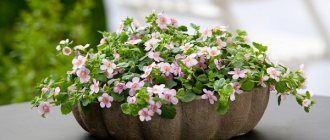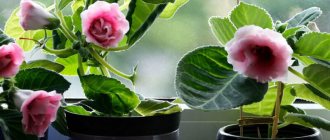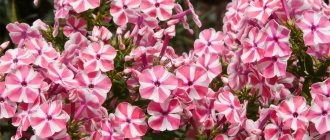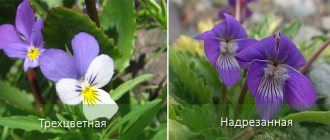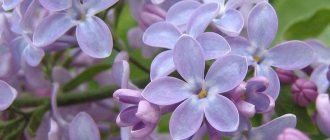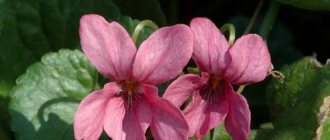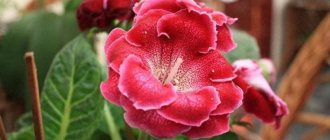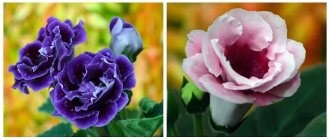The name comes from the Latin word for “to wash.” Why? The petals have such a mirror-like appearance, as if they had just been polished. People know her by the names: dog, wild and garden rose or khatma (a female Persian name). An interesting article about perennial primrose, its planting and care.
Description of the plant
Lavatera is a perennial or annual plant that grows throughout southern Europe and the African continent.
In addition to the basic species, a huge number of wonderful varieties of lavatera with a wide variety of petal colors are cultivated. A completely undemanding plant forms dense thickets, densely sprinkled with voluminous flowers reminiscent of gramophones. The popular name of Lavatera is “khatma” or “wild rose”. Lavatera bushes look amazing and natural in the garden plot and in the home greenhouse on the windowsill. Lavatera is distinguished by a powerful branched rhizome. The shoots are straight, spreading, up to 150 cm high, lined with velvety dark olive bark. Large branches are dotted with lobed leaves. Between the veins, the dark olive leaf blade is quite soft, rough or covered with tiny hairs. The upper leaves are much smaller than the basal leaves and grow opposite each other along the entire length of the stem.
Lavatera is popular due to its long, generous, marvelous flowering, which lasts from June to October. The corolla, shaped like a funnel, up to 10 cm long, is formed by five voluminous petals. The petals are painted either in one color or are endowed with a smooth transition of color from one shade to another. The petal becomes narrower closer to the center and has a grooved surface. Bisexual flowers, in the axils of the leaves and at the top of the stem, are collected in fleshy inflorescences, shaped like brushes. The inflorescences bloom in several copies and successively replace each other. In the center of the flower there is a short, rather dense column covered with long thread-like stamens and an ovary. Accompanying flowering is a sweet, tart aroma that attracts insects. Lavatera flower is an excellent honey plant.
After pollen is transferred from the stamens of the flower to the stigma of the pistil, fertilization occurs, then flat, cylinder-like seed pods ripen. Inside are elongated gray-resin seeds, which, when shaken, rattle, hitting the walls of the box. Ripe seeds have a gray-brown color; they do not stick to the walls of the box, but are easily shaken out of it. The time for wild rose seeds to ripen is at the beginning of autumn.
In order to collect lavatera seeds, you need to carefully cut off the capsules, scatter the seeds on a surface covered with paper, then dry them in a well-ventilated room. Store lavatera seeds in a canvas bag or paper bag.
Wild rose is used to decorate illuminated and shaded garden areas. Miniature lavatera bushes look very picturesque together with tall plants, for example, gladioli or park roses.
Lavatera after flowering
Collecting seeds
When the flowers have completely withered, you will see formed green boxes in the place where they grew. You should wait until they are fully ripe. Remember that mature seeds are only found in dried boxes that are colored brown. In order to understand whether it is time to collect seeds or not, you need to open one of these boxes. If the seeds in it are brownish-gray in color and easily fall out of the box, then collection can begin. As a rule, seed collection occurs at the beginning of September. Carefully trim the boxes and sprinkle the seeds from them onto a piece of newspaper at home. They should be dried well by placing them in a ventilated area. For storage, the seeds are placed in a paper bag or in a linen bag.
Wintering the annual
If you grow annual lavatera, then in the autumn it should be completely cut off and destroyed, and the ground should be dug up. It should be remembered that this plant easily propagates by self-seeding; therefore, with the onset of next spring, lavatera seedlings may appear on the site.
Wintering perennial
Lavatera perennial can be left in the soil for the winter. Its shoots bend to the surface of the soil and are fixed in this position. The bushes need to be covered with spruce branches, dried leaves or covering material.
Types and varieties
The genus includes 25 plant species; in culture - two types. The most widespread is the three-month-old lavatera, another frequently used species is the perennial lavatera (Thuringian).
Perennial Lavatera actively develops its root system in the first year of life. It blooms in the second year - in spring or early summer. Pleases with enchanting flowers until late autumn. To preserve decorativeness, faded buds are cut off.
Annual varieties are completely removed in the fall and the soil is dug up. Next year in the spring, self-seeding seedlings will appear in this place, which, after thinning, will form a new flowerbed. Perennial varieties are covered with spruce branches for successful overwintering. The stems are carefully pressed to the soil and pinned.
Lavatera varieties are distinguished by a riot of colors: everyone will find a variety that suits them in everything. Also, many gardeners create a mixture of lavatera species and varieties in their flowerbeds.
Three-month-old Lavatera: varieties
Three-month-old Lavatera is a plant with luxurious bushes up to 120 cm high. Lobed light turquoise leaves are located along the entire length of the shoots, becoming smaller and smaller closer to the top. In July, single flowers up to 10 cm in diameter, shaped like small gramophones, bloom in the leaf axils. Flowering is quite long and generous.
Lavatera "Pretty Woman"
Lavatera "Pretty Woman"
Lavatera red beauty is a variety that is a tall, spreading bush with large bright crimson, snow-white, pearlescent flowers.
Lavatera "Silver Cup"
Lavatera "Silver Cup"
Lavatera Silver Cup is a bush up to 70 cm high, covered with silver-crimson flowers with scarlet stripes. The flowers are large, funnel-shaped, open, approximately 10 cm in diameter. Representatives of this variety are cold-resistant and drought-resistant.
Lavatera Melange
Lavatera Melange
The plant is strong, highly branched, reaches a height of 90 cm. The diameter of the flowers varies from 6 to 9 cm, their shape is funnel-shaped, the color is snow-white, scarlet, and the color of strawberry. The buds appear in mid-summer and fade with the onset of cold weather. Lavatera melange is a cold-resistant variety that tolerates heat well and grows in almost any type of soil.
Lavatera Silver Cap
Lavatera Silver Cap
A plant with lush bushes. Lavatera Silver Cap is distinguished by salmon-colored flowers.
Lavatera "Mont Blanc"
Lavatera "Mont Blanc"
The bush is medium, up to 75 cm, densely leafy. Lavatera Mont Blanc is distinguished by numerous voluminous snow-white flowers without veins. Plant experts use this variety in group plantings to create hedges. Representatives of this variety do not require a garter.
Lavatera ruby queen
Lavatera ruby queen
Lavatera ruby is a variety characterized by scarlet colored flowers.
Lavatera New World
Lavatera New World
Lavatera new light is a strong, branched, unpretentious plant, up to 120 cm high. It blooms for a long time, abundantly and brightly, from the end of June until late frosts. The flowers are funnel-shaped, large, up to 10 cm in diameter. The shades of the flowers are snow-white, pale salmon and crimson. The plant is cold-resistant, light-loving and drought-resistant; there are no soil requirements. Grow by direct sowing in the ground or by seedlings. Representatives of the variety are attracted for planting in groups, rose gardens, and flower beds.
Lavatera "Novella"
Lavatera "Novella"
Annual. The first flowers appear on the plant when it grows to only 20 cm. During this period of time, the flower is excellent for pots, patios, and flowerpots. Lavatera novella is distinguished by voluminous flowers with a diameter of up to 10 cm, which retain their freshness for a long time, regardless of weather conditions. The plant has different heights depending on the place of cultivation: 20 cm in pots, 60 cm in open ground.
Lavatera Girlfriend
Lavatera girlfriend is a branched plant, 80-100 cm high. A variety with funnel-shaped, expressive, extraordinary flowers up to 10 cm in diameter, snow-white, salmon and pearlescent in color. Used for flower beds and cuttings, they look wonderful in row plantings.
Lavatera Thuringian
Lavatera Thuringian
Lavatera Thuringiana is a shrub up to 2 m high. Lavatera perennial (Thuringiana) is a species with straight, spreading shoots covered with leaves shaped like a round heart. Lavatera is a perennial plant with leaves and stems covered with hard, smoky hairs. Fleshy racemose inflorescences bloom by mid-June. The leaves of this species have healing properties.
Varieties:
- Mystic Marilyn - a bush up to 180 cm high, covered with scarlet or purple flowers;
- Bregon springs - pearlescent flowers with strawberry-colored stripes bloom on large shoots 1.3 m high;
- Barnsley Baby - a bush of medium height, covered with mother-of-pearl buds;
- Lilac Lady - has purple flowers;
- Bregon Springs - with salmon-colored buds;
- Burgundy Vine - blooms with pale pink flowers;
- Eye Catcher is a variety with crimson-pink flowers.
There is a biennial or tree-like lavatera. It grows up to two meters high and has a graceful stem with scarlet flowers, shaped like hibiscus inflorescences.
Tree lavatera
Varieties:
- Candy Floss - has flowers of a light ruddy hue;
- Rosea - distinguished by beautiful pale crimson flowers.
Description of lavatera with photos of flowers
The genus Lavatera belongs to the Malvaceae family and is represented by annual and perennial flowering varieties. It can have a herbaceous, shrubby, and, in the southern regions, a tree-like form. It was brought into cultivation in the 17th century, and since then it has been in consistently high demand due to its low maintenance requirements and discreet but pleasing appearance. Currently, numerous varietal and hybrid lines of lavatera with improved decorative characteristics have been developed.
The height of the bushes can reach 1.5-2 m, but there are also compact varieties no taller than half a meter. The root system is well developed, the crown is highly branched and strong. The leaves are lobed, rigid but short pubescent, arranged alternately. The flowers are large, with a five-leaf corolla, can grow singly or in a row of several pieces, are most often painted in pure colors (white, pink, yellow, burgundy, crimson), and there are also variegated inflorescences in delicate undertones. The buds are located at the ends of the shoots, forming terminal spike-shaped, rarely racemose inflorescences.
Flowering begins in June. The buds bloom on the shoots of the current year, and rise with them higher and higher as they grow, gradually decreasing in size. The last flowers can decorate the flowerbed until mid-autumn.
Lavatera can be used as a cut flower, keeping its fresh appearance in a vase with water for at least a week.
Lavatera care
Sometimes beautiful summer flowers do not please the eye with the beauty that was expected. The error most likely lies in improper care. With insufficient nutrition, the beauty of flowers soon disappears, so care must be taken to provide sufficient fertilizer. Lack of water, pests and diseases can also cause poor flowering. Therefore, it is so important to pay attention to proper plant care.
The rules for planting and caring for lavatera are quite simple.
- Periodic watering: the soil should not dry out completely, otherwise the seedlings may die.
- Providing lighting: due to lack of light, seedlings stretch out and their stems become weak. To obtain a sufficient amount of light, containers with seedlings are periodically turned towards the sun.
- Hardening: a couple of weeks before the expected date of planting the seedlings in a permanent place, the seedlings begin to be taken outside. First, the containers are left in shaded areas so that they do not burn in the sun, and then they are placed in a lighted area, constantly increasing the time the seedlings spend outside.
- Weed the lavatera if necessary. To avoid this unpleasant procedure, the soil between the lavatera bushes can be covered with a layer of mulching material.
- Mulching (or covering the soil) protects the soil surface from drying out, cracking, washing away, and reduces exposure to wind, sunlight and extreme temperatures.
Watering
Water supply to plants in the garden is necessary for the full development of the crop. Proper watering determines whether plants will sufficiently receive and absorb nutrients. However, if there is too much water, nutrients can be washed out of the soil. With superficial and insufficient watering, water will not be able to reach the roots. The consequence of this will be a delay in plant growth, since the water will evaporate already on the surface. With constant insufficient watering, plants will try to raise their roots closer to the surface, as a result of which they may suffer in dry weather or severe drought.
Important factors for determining the intensity of irrigation are the quality of the soil and the degree of its cultivation. Lavatera should be watered regularly, but even on hot days, one watering every seven days is enough. The top layer of soil must be allowed to dry out between waterings. You can water with a simple watering can: it is much more economical than using a hose. From the watering can, water flows specifically to the places where it is needed, and in the right quantity.
Top dressing
Wild roses can grow in poor soils, but it is better to enrich the soil with different types of fertilizers. This will allow the flowers to remain beautiful and the plant to remain strong. Flowers grown in rich soils produce more buds than those grown in poor soil. Typically, lavaters use organic additives to fertilize them, but on poor soils, mineral fertilizers can also be added to the soil. Crops are fed once a month. Use urea and nitroammophoska, dissolving them in water for irrigation. For abundant flowering, preparations with potassium and phosphorus are used.
Wild rose leaves are a dark olive hue, so as soon as they lighten, it becomes clear that the soil needs nitrogen and phosphorus. Fertilization is only necessary for extremely poor soils. As a rule, the nutrients added when planting flowers are enough for the plant to last for the entire period of flowering and growth. In the case when no fertilizers were applied when planting wild roses, complex fertilizers are added during watering.
Features of garden care
Decorative crops need proper care, namely:
- Systematic watering, especially when the plant begins to bloom. It is enough to water the flower beds every 2 days. On particularly hot days, it is worth spraying the leaf plates with warm water. Only the foliage can be moistened, since wet buds wither and fall off faster. In addition, they can curl.
- Applying fertilizing, which is especially important when growing crops on poor soil. It is recommended to add nitrophoska and urea (1 tablespoon per 10 liters of liquid). You can feed the plant during budding and in the spring.
- Systematic loosening of the soil every 5-7 days.
- Removing buds that have withered.
It is important to adhere to the rules of caring for bushes so that the lavatera is not susceptible to diseases and enjoys long-lasting flowering. It is worth considering that ornamental crops require abundant watering during the period of active growth of stems and at the time of bud formation. With the onset of September, the frequency of soil moistening procedures decreases.
Diseases and pests
Lavatera Thuringian
Adult representatives of wild roses are extremely rarely affected by fungal or bacterial diseases. Sometimes wild rose plantings can become infected with rust. For healing, the affected leaves are removed, burned, and the bush is treated with fungicides. If the plant is affected by more than 60%, then it is better to remove it from the site and burn it.
Wild roses are also rarely damaged by pests, but aphid attacks are possible. In case of plant diseases or pests, chemicals or folk remedies are used. For example, to kill aphids, many flower lovers use a mixture of soapy water and hot pepper.
When to plant lavatera?
Lavatera in the garden is an amazing and charming plant that becomes more beautiful every day and blooms luxuriantly. Lavatera is planted with seeds or seedlings. The time to plant garden roses is at the end of April. Any loose soil structure is suitable for the crop. The premature joy of a compact and lush flower bed fades due to too close planting. Garden roses need a fairly light and warm place and should not be too close to each other when planted.
Landing
Planting lavatera does not require much effort. Any site for planting wild roses is suitable, the main thing is that after heavy rains, water does not stagnate in this place. Due to excess moisture, the root system of the lavatera will rot. Sunny places are preferable; at least several hours a day, the place should be in direct sunlight and also be well ventilated.
The soil for rapid and long-lasting flowering of wild roses is best suited to be light and fertilized. Good ventilation of the plant's root area is important, while at the same time having sufficient water retention capacity - a condition that almost any well-kept garden soil fulfills.
Before planting flowers, it is advisable to dig up the soil, add humus, sand, ash and a complex of nutrients. Humus must be added at 2–3 liters per square meter, sand and ash are added in equal parts, depending on the type of soil. Mineral fertilizers for flowers are applied according to the instructions. When plants become crowded, thinning is required.
How to grow lavatera?
Lavatera is grown by planting seeds in open ground or seedlings. Flowers grown from seedlings bloom much earlier.
Growing lavatera from seeds: how and when to sow lavatera?
Fresh lavatera seeds have excellent germination, and the growing process is quite simple. Any novice gardener can master growing lavatera from seeds. Wild rose seeds can be sown directly into the ground or grown through seedlings. Sowing seeds in open ground occurs at the end of April, when the soil temperature reaches 18 degrees. Holes are made in the soil up to 4 cm deep, the distance between them is 25 cm. One or two lavatera seeds are sown in each hole, and after germination one of the strongest flowers is left.
After 14 days, the first seedlings, sensitive to low temperatures, appear. At night, to protect from freezing, the sprouts must be covered. When sowing wild rose seeds, you need to remember that they quickly lose their ability to germinate, so seeds that are more than three years old are unlikely to sprout successfully.
In order for the plant to produce buds before mid-summer, plant experts grow seedlings from seeds in mid-March. Prepare containers with drainage holes. Pots and cups are first doused with boiling water or water with the addition of manganese to disinfect them, then they are washed and dried. Pour drainage into the pots, then a mixture of deciduous soil and peat, water. Next, the seeds are planted, immersing them 1 cm into the soil. In general, the depth and frequency of sowing are very important. In too dense plantings, due to lack of air and light, fungal diseases develop especially intensively.
Before emergence, containers are covered with glass or transparent film to maintain a constant microclimate. Periodically, condensate is removed from the surface of the coating material. The first shoots may hatch in 10-12 days. As soon as they rise by 1-2 cm, the covering material is removed.
If some specimens of lavatera seeds take too long to germinate or the sprouts are weak, then such seedlings are thrown away; they will no longer please with abundant flowering. For full development, wild rose seedlings need a lot of sunlight. The air temperature should be about 20 degrees.
A month after emergence, if there is no threat of frost, the seedlings can be planted in open ground.
Transfer
Lavatera tolerates replanting well before flowering.
Reproduction
Wild roses reproduce well by seeds; a few pieces are enough for planting. The seeds germinate quickly and in the future, with proper sowing and care, provide good seed material. In subsequent years, you can plant your own seeds on the site. Lavatera can be grown either by direct sowing in open ground or by seedlings.
Some secrets of growing lavatera
Wild rose is not capricious, but, nevertheless, it is advisable to take into account some nuances of care. In the process of planting young specimens of the lavatera flower in open ground, you need to remember the need to leave a distance of about 30 cm between plants. The more magnificent the perennial grows in the future, the more space it will need.
For June flowering of wild roses, seeds should be planted on seedlings in March-April. If you plant the seeds in the ground at the beginning of May, you will be able to admire the buds in 2.5 months. To prolong flowering, lavaters periodically collect ripe, undried seeds. The process of collecting seeds is not a troublesome task: the buds fade and seed boxes appear in their place. It is recommended to remove the boxes from the bush when they acquire a brown tint, and when tapped, the seeds spill out. Store the seeds in a dry place, this will extend their germination up to 5 years.
Lavatera: planting seeds for seedlings
If you want to see Lavatera bloom quickly, then it makes sense to plant the flower through seedlings. When to plant lavatera seedlings ? If the seedlings will be planted in open ground at the end of May, then the seeds should be sown in the first ten days of March. Containers are prepared for these purposes. Drainage is laid at the bottom and soil mixture is poured. Make beds in the ground no more than 1 cm deep, spill with warm water and sow the seeds. The container is covered with film or glass. The crops are ventilated daily for 30 minutes. Condensation is removed from the glass with a rag and watered regularly. As a rule, the first shoots appear after 2 weeks.
It should be remembered that when planting seedlings, seedlings should be provided with lighting. Because if the plants do not have enough light, they will stretch out and become thin and weakened. As soon as the seedlings grow up, they will need to remove the shelter. The shelter is removed gradually every day, increasing the ventilation time.
Do not forget to rotate the container around its axis, so the seedlings will grow evenly and will not stretch in one direction or another.
Picking
Khatma is not dived. As soon as the lavatera seedlings become strong, they can be immediately planted in open ground.
Lavatera in landscape design
It is very important what flowers grow on the site, because the garden also reflects the personality of the owner, just like his house. Nothing has the power to change the appearance of a home like a green, blooming environment. The variety of lavatera varieties allows connoisseurs of these beautiful flowers to choose and plant specimens according to their taste in the flowerbed. Lavatera in landscape design is used as a luxurious decoration for borders, flower beds, and garden gazebos. Wild rose goes amazingly with irises, sage, verbena, phlox, and dahlias.
Reproduction methods
The easiest way to propagate three-month-old khama is by seeds. The plant grows well by self-sowing. If you don’t collect ripe seeds in the fall, they will definitely sprout in the spring. When grown in temperate regions, the seeds can be sown directly into the ground. This is done in the last ten days of April.
Collect seeds in autumn
The boxes should dry and turn dark brown. When you touch them, a rustling sound is heard. In regions with cold winters and recurrent frosts, khatma is sown as seedlings in greenhouses. They do this in March in order to transplant the seedlings into the flowerbed in May.
Application in medicine
Traditional healers actively use the beneficial properties of wild roses, which help against many ailments. The medicinal raw materials are leaves, roots and flowers. The leaves are collected at the budding stage of the plant. Dry outdoors under a canopy or in a well-ventilated area. The roots are dug up in the fall. Dry in an oven or dryer at a temperature of 50-60 degrees. Leaves and flowers are stored for 2 years in a closed glass container, and roots are stored in boxes or bags.
Lavatera leaves contain vitamin C and are used to treat skin diseases and rashes. A decoction of lavatera roots helps patients with lung diseases, relieves cold symptoms, and helps solve problems of the digestive system. An ointment prepared using dried lavatera leaves relieves acute pain in joint and muscle diseases or peripheral nerve damage.

